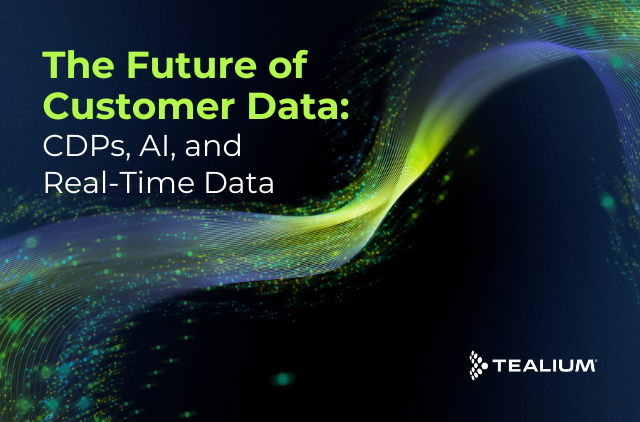In today’s hyper-digital world, the way we engage with consumers has dramatically changed and identity resolution has become increasingly important. Your customers now expect more personalized experiences than ever before and 72% of them say they will even switch brands if those expectations are not met.
On top of that, third-party cookie loss is quickly approaching and it’s bringing new data privacy legislation along with it. These changes have already begun impacting marketers’ abilities to identify customers across channels and communicate with them in the most relevant way possible.
So what is the new method for recognizing customers and delivering highly tailored experiences in this new era?
Keep reading to see key takeaways from our session with eMarketer on strategies for creating the data foundation you need to keep up with the changing customer data landscape or skip to the on-demand session right here.
The Main Changes Impacting the Identity Resolution Landscape
Third-Party Cookie Loss
While third-party cookie loss has been postponed to 2023, it has already impacted marketers’ abilities to get a clear view of their customers and meet these new personalization expectations. However, some brands have begun using probabilistic matching to fill these gaps that third-party cookie loss has left in customer profiles.
For those who have not heard of probabilistic matching, it is essentially exactly what it sounds like. Probabilistic matching uses a statistical approach to measure the probability that two customer records represent the same individual. It’s kind of like putting together a puzzle with pieces from all different boxes – it’s hard to tell which piece is from which box but the edges of them make it seem like they might go together but you really can’t be sure.
That said, probabilistic identity resolution comes with its own complications. Because this method relies on guessing and estimations, it can lead right back to the original problem of irrelevant messaging based on inaccurate data.
Regulatory and Browser Changes
Along with heightened personalization expectations, consumers are now also expecting brands to prioritize their data privacy. As browsers like Safari and Google have already begun making adjustments to accommodate these consumer privacy requests, this only makes it more difficult for marketers to access clear pictures of their customers.
The key to balancing privacy and personalization is by implementing a first-party data strategy. By starting with data that’s collected from the source and given with consent, you can more easily keep pace with the momentum of CCPA/GDPR and new regulations. This strategy also fosters customer loyalty and trust because you are only capturing data that has been willingly given.
A First-Party Data Approach to Identity Resolution
If you haven’t caught on, the theme here is data deprecation, meaning marketers just don’t have as much or as easy of access to the crucial insights they need to meet the consumer expectations just discussed.
So again, what is the way forward here?
In order for brands to succeed today and stay agile in the coming months, they’ll need a strategy that doesn’t consist of temporary patchovers. Instead, brands need a first-party data strategy that has privacy baked in from the start and utilizes deterministic matching to accurately identify their customers so they can establish data independence and say goodbye to third-party cookies with confidence.
Your First Steps for Switching to a First-Party Data Identity Resolution Strategy
Step 1: Identify what first-party data is already available
Start by canvasing the data sources or campaigns that are already collecting first-party data identifiers. Examples of first-party data identifiers include email addresses captured from a webpage or mobile app login, or a phone number collected from a call center. From there, you can see what pieces are missing in your identity resolution and work to incorporate strategies to collect them that still honor customer privacy and drive personalization.
The next portion of these identifiers is connecting them to form complete customer profiles that allow you to see the gaps and Tealium’s Customer Data Platform (CDP) does just that. Our AudienceStream CDP not only unifies that first-party data in real time, but also creates a standardized and neutral layer that enables you to capture every piece of data from each layer of your tech stack.
Step 2: Understanding Visitor Stitching and the Importance of Deterministic Matching
Having this standardized data layer creates a solid foundation for deterministic matching. While probabilistic matching relies on guesswork, deterministic matching on the other hand utilizes those known first-party data identifiers to accurately connect customer data and attribute it to the right customer.
Deterministic matching at its core relies on standardized data. And while that may seem difficult to achieve, a first-party data strategy executed by a CDP like AudienceStream not only simplifies this process, but also helps to future-proof your organization. Again, staying agile is not about implementing costly and temporary solutions that will constantly require adjustments. Instead, staying agile starts with building a customer data strategy that is centered around timeless, clean, consented, and standardized data.
Step 3: Using Value Exchange to Prioritize Privacy and Personalization
The last step of switching to a first-party data strategy really focuses on filling in those gaps in your customer profiles for better identity resolution. In this case, using value exchange, or the process of offering something of value to your customers in exchange for pieces of first-party data, not only closes those gaps but also facilitates trust and personalization. An example of value exchange could be offering 20% off on a purchase in exchange for their email address, but the value does not always have to be something monetary.
For instance, Tealium customer New Balance offers custom fitness tracking in exchange for information like email address, name, phone number, preferred activity types, and fitness goals. New Balance then uses this information to better understand their customers and tailor experiences accordingly like recommending customers specific shoes catered to their preferred activity types or notifying them that it’s time for a new pair of shoes after the customer has run a certain number of miles.
This balance of privacy and personalization is what will help your organization keep up with future changes. Again, if you are baking privacy in from the start by collecting consented, first-party data then you are setting yourself up for agility.
Tealium has always been a data-first CDP, meaning we help you capture clean and accurate data from the start and unify it with deterministic matching to help you deliver tailored experiences that create customers for life.
Interested in learning more about how Tealium can help your organization? Get a personalized demo today!







